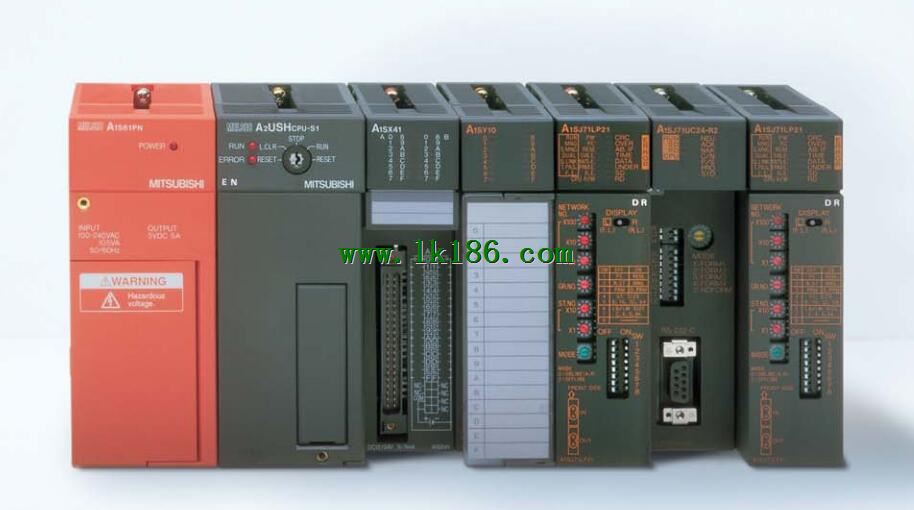
Number of channels: 4 channels.
Sensing method and temperature range: PT100.
A1S64TC series component is a kind of temperature controller combined with ANS series CPU.
Components with temperature measurement input and built-in PID algorithm control output, can be used in a variety of temperature control occasions A1SJ-56DT.
Each component controls up to 4 loops at most..
Thermocouple input or PT100 3 wire temperature sensor input.
Control output switching signal for the output of the transistor A1SJ-56DT.
BW is a signal with broken line detection function. 32 point connector for compression connector (40 pin connector.
Input points: 32 points.
Input voltage and current: 7mA DC24V.
Input response time: 10ms.
16 point /1 a public side.
Positive pole sharing.
Output points: 24 points A1SJ-56DT.
Output voltage: DC24V.
OFF leakage current: 0.1mA.
Output response time: 12ms.
Output type: transistor output.
8 point /1 a public side.
With the surge absorber.
34 point terminal station.
PLC is introduced by the relay control technology after the development of micro processing technology,
Can be easily and reliably used for switching control MITSUBISHI A1SJ-56DT.
As the analog quantity can be converted into digital quantity, the number of digital quantity is just a number of switching value,
Therefore, after the conversion of analog, PLC can also be reliable for processing control MITSUBISHI A1SJ-56DT.
Because the continuous production process often has the analog quantity, the analog quantity control is sometimes called process control.
Analog quantity is not electricity, and PLC can only handle digital quantity, quantity of electricity.
All to realize the conversion between them to have the sensor, the analog quantity into a number of power MITSUBISHI A1SJ-56DT.
If this power is not standard, but also through the transmitter,
The non-standard power into a standard electrical signal, such as 1-5V, 4-20mA, 0-10V, etc..
At the same time, there is also an analog input unit (A/D),
Transform these standard electrical signals into digital signals,
The analog output unit (D/A), in order to transform the digital quantity after PLC processing into analog quantity -- standard electric signal.
So the standard telecommunication number, the conversion between the number of operations to use a variety of computing.
This requires the resolution of the analog unit and the standard electrical signal. 10BASE-T.
The structured text programming language uses the computer description method to describe the various kinds of relations between the various variables in the system,
Complete the required function or operation.
Most PLC manufacturers use structured text programming language similar to BASIC language, PASCAL language or C language and other advanced languages,
But in order to be convenient, the expression methods of the statement and the types of statements are simplified.
Structured text programming language features: the use of high-level language programming, you can complete the complex control operations,
Need to have a certain level of computer knowledge and programming skills,
Higher requirements for engineering designers. Poor visibility and operability.
Switching value, also known as logic, refers to only two values, 0 or 1, ON or OFF.
It is the most common control, it is the advantage of PLC control,
Is also the most basic application of PLC.
Switch volume control is designed to,
According to the current input combination of the switch quantity and the history of the input sequence,
So that PLC generates the corresponding switching output,
In order to make the system work in a certain order.
So, sometimes also known as the order control.
And sequential control is divided into manual, semi-automatic or automatic.
And the control principle is decentralized, centralized and hybrid control three.
PLC is introduced by the relay control technology after the development of micro processing technology,
Can be easily and reliably used for switching control.
As the analog quantity can be converted into digital quantity, the number of digital quantity is just a number of switching value,
Therefore, after the conversion of analog, PLC can also be reliable for processing control.
Because the continuous production process often has the analog quantity, the analog quantity control is sometimes called process control.
Analog quantity is not electricity, and PLC can only handle digital quantity, quantity of electricity.
All to realize the conversion between them to have the sensor, the analog quantity into a number of power.
If this power is not standard, but also through the transmitter,
The non-standard power into a standard electrical signal, such as 1-5V, 4-20mA, 0-10V, etc..
At the same time, there is also an analog input unit (A/D),
Transform these standard electrical signals into digital signals,
The analog output unit (D/A), in order to transform the digital quantity after PLC processing into analog quantity -- standard electric signal.
So the standard telecommunication number, the conversion between the number of operations to use a variety of computing.
This requires the resolution of the analog unit and the standard electrical signal.
The length of time required to execute the instruction, the length of the user''s program, the type of instruction, and the speed of the CPU execution are very significant,
Generally, a scanning process, the fault diagnosis time,
Communication time, input sampling and output refresh time is less,
The execution time is accounted for the vast majority of A1SJ-56DT.
